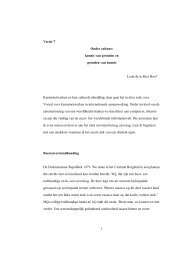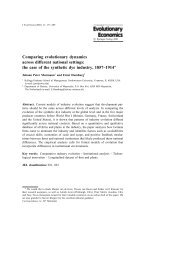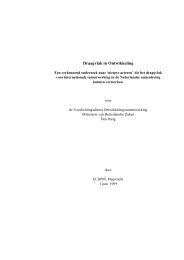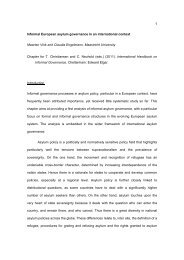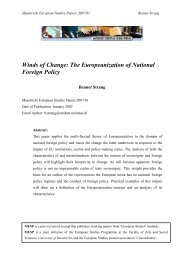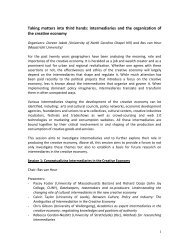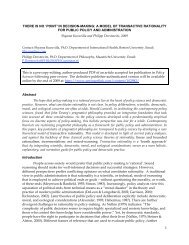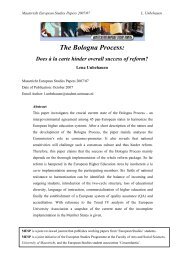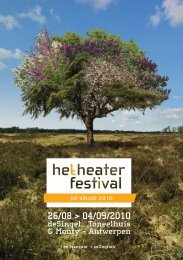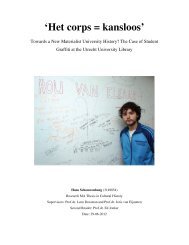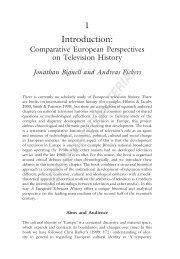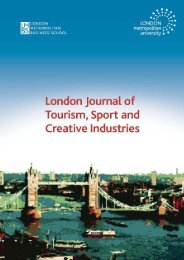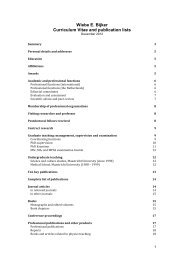Crossing the divide: - Maastricht University
Crossing the divide: - Maastricht University
Crossing the divide: - Maastricht University
Create successful ePaper yourself
Turn your PDF publications into a flip-book with our unique Google optimized e-Paper software.
Quite soon, however, <strong>the</strong> model proved to be dead wrong. Experiences in <strong>the</strong> early<br />
1950s showed that “<strong>the</strong> technical knowledge, required in tropical countries, was not<br />
available in <strong>the</strong> West, or at least not ready for its application in o<strong>the</strong>r than Western<br />
conditions” (Ponsioen 1968: 60). Never<strong>the</strong>less, <strong>the</strong> technology transfer model<br />
continued to inspire aid or cooperation policies for decades to come. A model that<br />
was outdated at <strong>the</strong> outset was to inspire generations of policymakers, scientists<br />
and technologists, be <strong>the</strong>y diplomats of <strong>the</strong> 1940s, industrial engineers in <strong>the</strong> 1950s,<br />
or biotechnologists in <strong>the</strong> 21st century. Was Claude Alvares, <strong>the</strong> Indian writer with a<br />
deep mistrust of <strong>the</strong> ‘modern knowledge industry’ right, when he compared science<br />
with toothpaste, and dismissed <strong>the</strong>m both as ‘irrelevant to life’?<br />
Why recount this early history? Because it shows how scientists and technologists<br />
have been involved from <strong>the</strong> very start in <strong>the</strong> shaping of official development aid or<br />
technical assistance: <strong>the</strong>y had a stake in it (as unemployed experts in Europe) and<br />
<strong>the</strong>y helped shape its rationale or <strong>the</strong>ory (as in Rostow’s work). Both <strong>the</strong> older<br />
history (<strong>the</strong> creation of institutes and universities in <strong>the</strong> 19 th Century) and <strong>the</strong> more<br />
recent one just mentioned, need to be understood before a structured dialogue can<br />
take place.<br />
Scientific interest has <strong>the</strong>refore closely interacted with <strong>the</strong> rationale for technical<br />
assistance. Rostow’s modernisation <strong>the</strong>ory provided a basis for technology transfer,<br />
and made for a very special type of donor support that suited particular interests.<br />
Claude Alvares (1997: 294) has attacked <strong>the</strong>se unholy alliances between science<br />
and <strong>the</strong> state, as imposing an element of Western culture over poor countries.<br />
I, however, do not subscribe to a conspiracy <strong>the</strong>ory, which argues that scientists<br />
from developed countries only saw it as being in <strong>the</strong>ir interest to provide this type of<br />
aid. Aid has always had too many interests or motivations associated with it to just<br />
link it to one interest group.<br />
I would point out, however, that a close relation has existed between science and<br />
development aid from <strong>the</strong> very start in <strong>the</strong> late 1940s, and that a <strong>the</strong>oretical model<br />
was adopted in which science was accorded a special place in <strong>the</strong> development<br />
process. The model continued to be operative, even though its faults soon became<br />
evident. In o<strong>the</strong>r words: Nor<strong>the</strong>rn scientists had a significant role in <strong>the</strong> setting of<br />
developmental priorities, especially in <strong>the</strong> area of scientific and technological<br />
cooperation. O<strong>the</strong>r actors were poorly represented in <strong>the</strong> agenda setting. A policy<br />
dialogue, which seriously involved actors from <strong>the</strong> South, was slow in <strong>the</strong> coming.<br />
Where do we stand now? The Human Development Report argues “Technology<br />
networks are transforming <strong>the</strong> traditional map of development, expanding people’s<br />
horizons and creating <strong>the</strong> potential to realise in a decade progress that required<br />
generations in <strong>the</strong> past”. The report links technological transformation to<br />
globalisation and concludes that toge<strong>the</strong>r <strong>the</strong>y are creating a new paradigm: <strong>the</strong><br />
network age (UNDP 2001: 27). Whose networks?



